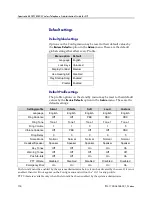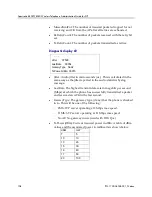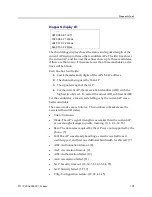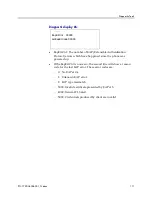
Diagnostic Tools
PN: 1725-36038-001_N.docx
109
Diagnostic display #3:
........
9970 060 -67 c011
7020 064 -71 Weak
a340 116 -72 Weak
b2e0 153 -72 Rate
The third debug display shows the status and signal strength of the
current AP and up to three other candidate APs. The first line shows
the current AP, and the next three lines show up to three candidates,
if there are that many. If there are fewer than three candidates, extra
lines will be blank.
Each line has four fields:
1.
Last 4 (hexadecimal) digits of the AP’s MAC address.
2.
The channel being used by that AP.
3.
The signal strength of that AP.
4.
For the current AP, the Association Identifier (AID) with the
highest two bits set. To extract the actual AID, subtract 0xc000.
For the candidates, a reason code telling why the current AP was a
better candidate.
The reason codes are as follows: The numbers in brackets are the
associated handoff codes)
•
Unkn: Unknown
•
Weak: The AP’s signal strength was weaker than the current AP,
or not enough stronger to justify roaming. {0, 1, 2, 6, 12, 13}
•
Rate: The data rates required by the AP were not supported by the
phone. {5}
•
Full: The AP was already handling as much voice traffic as it
could support, and had no additional bandwidth for this call. {7}
•
AthT: Authorization timeout. {8}
•
AscT: Association timeout. {9}
•
AthF: Authorization failed. {10}
•
AscF: Association failed. {11}
•
SecT: Security timeout. {29, 30, 31, 32, 33, 34, 35}
•
SecF: Security failed. {37, 39}
•
Cnfg: Configuration failure. (19, 38, 41, 45}
















































